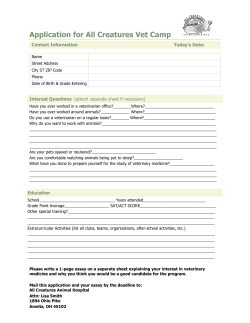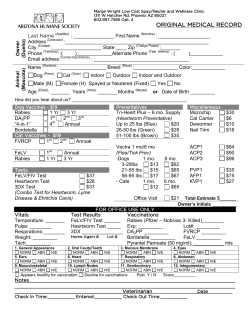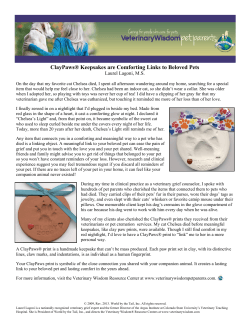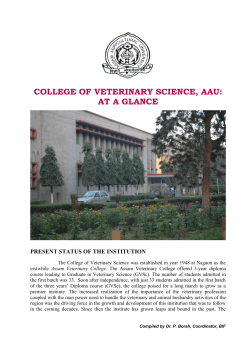
Adequate Veterinary Care Introduction
Adequate Veterinary Care Introduction These guidelines were prepared by the American College of Laboratory Animal Medicine (ACLAM) to assist in the formulation and evaluation of programs of veterinary care for laboratory animals. The professional judgment of a trained and experienced veterinarian is essential in the application of these guidelines to specific institutional settings. The ACLAM recognizes that both regulatory and science sponsoring agencies such as the United States Department of Agriculture (USDA) and the Public Health Service of the United States Department of Health and Human Services (PHS/DHHS), through their respective regulations and policies, support the concept of "adequate veterinary care" within their own range of interest and specialization. This document, written by ACLAM, an organization comprised of veterinarians certified in the specialty of laboratory animal medicine, is a detailed description of adequate veterinary care and is intended to apply to animals used, or intended for use, in research, teaching or testing. ACLAM Position On Adequate Veterinary Care The institutional veterinarian must be qualified by virtue of appropriate postgraduate training or experience in laboratory animal science and medicine. Such training and experience are indicated by certification by ACLAM and/or participation in laboratory animal medicine continuing education activities of ACLAM and the American Society of Laboratory Animal Practitioners. The continuing education of the veterinarian is an essential component of maintaining competence. The extent of the veterinary care program will depend on several factors, such as: 1. the number of animals, 2. the species used and 3. the nature of the experimentation conducted. Large units may need several veterinarians to fulfill the program's requirements. One veterinarian may be sufficient in moderately sized units, and a part-time or consulting veterinarian may be acceptable in small units. However, in all cases, formal arrangements for the provision of veterinary care must be made. Consulting veterinarians must make regularly scheduled visits (frequency based on need), and arrangements must be made to assure that veterinary services are readily available at all other times to meet either routine or emergency needs. The veterinarian responsible for supporting an institutional animal care and use program must have appropriate authority to execute the duties inherent in assuring the adequacy of veterinary care and overseeing other aspects of animal care and use to ensure that the program meets applicable standards. The veterinarian must be fully knowledgeable concerning the current and proposed use of animals in the institutional research, testing and teaching programs. At least one veterinarian must be a full member of the Institutional Animal Care and Use Committee (IACUC) and actively involved in the review of all protocols and projects, and in the inspection of facilities and review of institutional programs involving animals in research, testing and teaching. For the veterinary care program to be judged "adequate," there is a continuing institutional responsibility to foster and support enhancement of the program through the identification and adoption of techniques, procedures and policies that improve laboratory animal health and well-being. ACLAM endorses the American Veterinary Medical Association Principles of Veterinary Ethics and the specific guidelines regarding veterinarians employed by other than veterinary medical organizations. Veterinarians must be especially vigilant in ensuring that their professional veterinary judgments are neither influenced nor controlled by institutional interests to the detriment of the laboratory animals. The provision of adequate veterinary care involves the following primary areas of responsibility: A. Disease Detection and Surveillance, Prevention, Diagnosis, Treatment and Resolution 1. The isolation, quarantine and stabilization programs for newly arrived animals are necessary to provide time to assess their health status, allow them to recover from the stress of shipment and an opportunity to adapt to their new environment. The extent of these programs depends on several factors, including species and source of the animals as well as their intended use. For some animals, such as rodents obtained from reliable sources for which health status is known, visual inspection on arrival may suffice. For species such as nonhuman primates, farm animals, wild animals, random source dogs and cats, and non-specific pathogen free rabbits and rodents, appropriate quarantine and isolation procedures must be employed. 2. Preventive medicine programs such as vaccinations, ecto- and endoparasite treatments and other disease control measures should be initiated according to currently acceptable veterinary medical practices appropriate to the particular species and source. Only animals of defined health status should be used in research and testing unless a specific, naturally occurring or induced disease state is being studied. Systems 3. 4. 5. 6. 7. should be established to protect animals within the institution from exposure to diseases. Transgenic and mutant animals may be particularly susceptible to diseases and may require special protection to ensure their health. Systems to prevent spread of disease may include facility design features, containment/isolation equipment, and use of standard operating procedures. Training of animal care and research staff is essential to prevent spread of animal diseases. Daily observation of all animals by a person or persons qualified to verify their well-being is required. It is not necessary for a veterinarian to personally make this assessment each day. However, at a minimum, a trained paraprofessional or technician must observe each animal every day and there must be a timely and accurate method for conveying information regarding animal health, behavior and well-being to the veterinarian. Disease surveillance is a major responsibility of the veterinarian and should include routine monitoring of colony animals for the presence of parasitic, bacterial and viral agents that may cause overt or inapparent disease. Additionally, cells, tissues, fluids, and transplantable tumors that are to be used in animals should be monitored for infectious or parasitic agents that may cause disease in animals. The type and intensity of monitoring necessary will depend upon professional veterinary judgment and the species, source, use and number of animals housed and used in the facility. Diagnostic laboratory services must be available and used as appropriate. Laboratory services should include necropsy, histopathology, microbiology, clinical pathology, serology, and parasitology as well as other routine or specialized laboratory procedures, as needed. It is not necessary that all of these services be available within the animal facility if other laboratories with appropriate capabilities are available and used. Animals with infectious disease must be isolated from others by placing them in isolation units or separate rooms appropriate for the containment of the agents of concern. In certain circumstances, when an entire group of animals is known or thought to be exposed or infected, it may be appropriate to keep the group intact during the time necessary for diagnosis and treatment, for taking other control measures, or for completion of a project. The veterinarian must have authority to use appropriate treatment or control measures, including euthanasia if indicated, following diagnosis of an animal disease or injury. If possible, the veterinarian should discuss the situation with the principal investigator to determine a course of action consistent with experimental goals. However, if the principal investigator is not available, or if agreement cannot be reached, the veterinarian must have authority to act to protect the health and well-being of the institutional animal colony. The veterinarian's authority should be exercised with the concurrence of the IACUC and the Institutional Official. B. Handling and Restraint; Anesthetics, Analgesics and Tranquilizer Drugs; and Methods of Euthanasia Adequate veterinary care includes providing guidance to animal users and monitoring animal use to assure that appropriate methods of handling and restraint are being used and to ensure proper use of anesthetics, analgesics, tranquilizers, and methods of euthanasia. Written guidelines regarding the selection and use of anesthetics, analgesics and tranquilizing drugs and euthanasia practices for all species used must be provided and periodically reviewed by the veterinarian. Guidelines may be developed in-house or provided by specific references to the current veterinary literature. In addition, the veterinarian or trained paraprofessionals should provide formal or informal instruction in the proper use of such agents and euthanasia procedures. The veterinarian must have the responsibility and authority to assure that handling, restraint, anesthesia, analgesia and euthanasia are administered as required to relieve pain and such suffering in research animals, provided such intervention is not specifically precluded in protocols reviewed and approved by the IACUC. The veterinarian must exercise good professional judgment to select the most appropriate pharmacologic agent(s) and methods to relieve animal pain or distress in order to assure humane treatment of animals, while avoiding undue interference with goals of the experiment. C. Surgical and Postsurgical Care A program of adequate veterinary care includes the review and approval of all preoperative, surgical and postoperative procedures by a qualified veterinarian. The institution bears responsibility and must assure, through authority explicitly delegated to the veterinarian or to the IACUC, that only facilities with programs appropriate for the intended surgical procedures are utilized and that personnel are adequately trained and competent to perform the procedures. The veterinarian's inherent responsibility includes monitoring and providing recommendations concerning preoperative procedures, surgical techniques, the qualifications of institutional staff to perform surgery and the provision of postoperative care. D. Animal Well-Being Adequate veterinary care includes responsibility for the promotion and monitoring of an animal's well-being before, during and after experimentation or testing. Animal well-being includes both physical and psychological aspects of an animal's condition evaluated in terms of environmental comfort, freedom from pain and distress and appropriate social interactions, both with conspecifics and with man. The veterinarian must have the authority and responsibility for making determinations concerning animal well-being and assuring that animal well-being is adequately monitored and promoted. The veterinarian must exercise this responsibility in review of animal care and use protocols, and must have the authority to remove an animal from an experiment which is adversely affecting its well-being beyond a level reviewed and approved by the IACUC. The following examples represent how this responsibility can be met: 1. Ensuring the adequacy of the physical plant, caging and ancillary equipment. 2. Developing, implementing and monitoring sound animal care (husbandry) programs including such areas as sanitation, nutrition, genetics and breeding and vermin control. 3. Establishing an acclimatization program to adapt animals to either shortterm or long term restraint procedures. 4. Improving and enriching an animal's environment to minimize the development of physical or behavioral abnormalities. 5. Providing appropriate opportunities for human-animal socialization and acclimatization to the research environment or procedures. 6. Performing periodic physical and clinical evaluations appropriate for the species and the experimental situation. 7. Providing pre-procedural and post-procedural care in accordance with current established veterinary procedures. E. Appropriate Use of Animals in Research and Testing The veterinarian must be involved in the review and approval of all animal care and use in the institutional program. This includes advising on the design and performance of experiments using animals as related to model selection, collection and analysis of samples and data from animals, and methods and techniques proposed or in use. This responsibility is usually shared with investigators, the IACUC, and external peer reviewers. Related Concerns Other areas of professional concern and responsibility for the veterinarian which may not strictly be part of the ACLAM description of adequate veterinary care include the following: 1. Participating in the development and administration of training for institutional staff in the care and use of laboratory animals. 2. Assisting institutional health officials to establish and monitor an occupational health program for all animal care workers and others who have substantial animal contact. 3. Monitoring for zoonotic diseases such as leptospirosis, toxoplasmosis, rabies, Q-fever, B-virus infection, hantavirus infection, and lymphocytic choriomeningitis. 4. Advising on and monitoring of standards of hygiene among institutional staff involved with research animal care and use. 5. Advising on and monitoring of biohazard control policies and procedures as they apply to research animal care and use. Conclusions The Diplomates of the American College of Laboratory Animal Medicine believe that adequate veterinary care is an integral component of humane animal care and use in research, teaching and testing and further, that the state of animal well-being ensured through adequate veterinary care is essential to reliability of results from experimentation with animals. The essential components of adequate veterinary care programs for laboratory animals include: a. one or more qualified veterinarians and veterinary technical staff, b. authority to implement the veterinary care program and provide oversight of related aspects of the institutional animal care and use program, c. disease prevention, diagnosis and control programs, d. guidance for research staff in animal methods and techniques, and e. the promotion of animal well-being.
© Copyright 2025





















